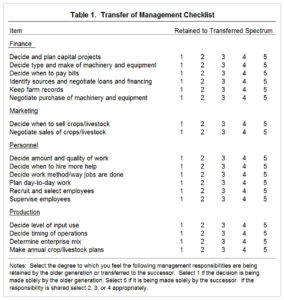An update last week at the farmdoc daily blog (“Transferring Business Management“) indicated that, “Transferring business management between generations is one of the most critical steps in transitioning the business from an older generation to a younger generation. Having said that, in numerous instances, this step is given little thought. Transitioning management cannot be done overnight, and often requires a trial and error approach before it can be determined how each generation fits into the multiple generation business. This article briefly describes some of the key factors that need to be considered when transitioning business management from an older generation to a younger generation.”
The farmdoc item explained that, “In addition to adapting a method to make business decisions, it is important to think about how daily management responsibilities are divided between the two generations. Again, this occurs after the younger generation has been given a chance to manage part of the business. Dividing management responsibilities between parties often leads to more expedient and better decisions. Obviously, individual interests and skills should be considered when dividing responsibilities. There are two primary methods that can be used to divide responsibilities. The first method divides responsibilities by enterprise. The second method divides responsibilities by function (e.g., finance, marketing, personnel, or production). Under both of these methods, decisions that affect the entire business would need to be made by both parties using the general manager or equal voice approach. It is also common to make joint decisions regarding major asset purchases, regardless whether these assets pertain to just one enterprise or function.
“The discussion above makes the management transfer process seem smooth with few hiccups. This is often not the case. Given that this is the case, it is often helpful to use a management transfer worksheet or checklist. Table 1 contains a checklist that can be used to keep track of the transfer of specific duties. This checklist was adapted from Baker (2006). The duties are separated by function. Both short-term and long-term management tasks are included in the table.”

Table from, “Transferring Business Management.” farmdoc daily Blog, April 7, 2017, by Michael Langemeier.
Last week’s update added that, “Every two-generation arrangement reaches the point where the older generation withdraws from active management of the business. This is often a difficult time for the older generation. To the extent that they are interested, keeping the older generation involved in the operation by helping during peak labor periods (e.g., planting or harvesting), and asking for their advice can ease their transition out of an active management role.”
“After concluding that both generations are committed to adding someone to the operation and determining that there will be sufficient income for both parties; it is imperative to develop a transition plan involving management transfer. This plan needs to address goals and objectives of both parties, the initial management transfer steps, decision-making authority, and division of management responsibility,” the farmdoc update said.

